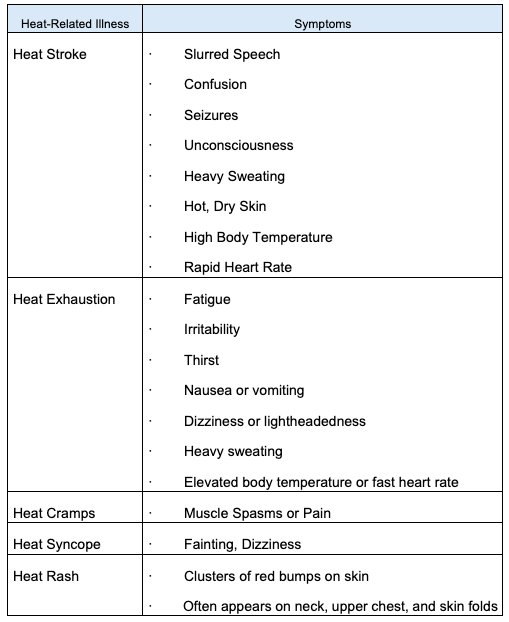Recognizing and Managing Heat Related Illness
by Jeremy Beagle, CIH, CMCC, CMC
For many of us, summer is here. The south and southeast have been experiencing above average temperatures for the past month and for the rest of us, summer is on its way. With the summer solstice on the horizon, it is as good as any time to talk about and recognize the hazards associated with heat exposure. First and foremost, hazardous heat exposure does not only occur during the summer months or outdoors. Heat related illness can occur during any season and anywhere, given the right environment. For many, the consideration of heat exposure is highest when the outside environment is persistently heating up. In many cases, physical activities will exacerbate conditions leading to a heat related illness.
The human body has a remarkable ability to remove excess heat through dissipation or cooling. The body performs this function primarily through evaporation or what is commonly known as perspiration. As the temperature increases, the body will begin to produce sweat which will evaporate from the surface of the skin. As the sweat evaporates, it removes heat energy from the surface of the skin, in turn, cooling the skin. The process helps maintain a functional body temperature. Conduction is another common method to cool the body. Conduction is the transfer of thermal energy between two objects that are contacting each other. Think about a cold swimming pool or jumping in a creek. The heat energy in your body is transferred into the water. When the body is not cooling quick enough, the internal temperature continues to increase. As the temperature increases, so does the likelihood of adverse effects such as thirst, irritation, cramping, heat exhaustion and heat stroke.
Whether you are a worker or the general public, it is important to be familiar with heat related illnesses and their symptoms. The following table describes various heat-related illnesses and their symptoms. This information was obtained from OSHA. If these symptoms are experienced, it is imperative to provide first aid. With heat related illness, time is of the essence.

The following is some advice for the treatment of a heat related illness. Diagnosis can oftentimes be difficult as many of the symptoms can occur at the same time. Rapid treatment is of the utmost importance and can be the deciding factor regarding the health of the person.
Cramping
In many instances, cramping occurs during physical activities and is experienced in the legs, arms or stomach muscles. Salt and moisture levels are reduced. Common treatments include, but are not limited to:
- Stop the activities and sit in a cool place
- Drink water or a sports drink
- Do not continue activity for a few hours after the cramping has stopped
- Seek medical attention if the cramping has not stopped after an hour or if you have a heart condition or are on a low-sodium diet
Heat Exhaustion
Heat exhaustion happens when the body has lost too much water and salt as the body sweats. If heat exhaustion is not treated, it can turn into heat stroke. Common treatments include, but are not limited to:
- Drinking cold water or a sports drink
- Rest in a cool area lying down
- If able, move to an air-conditioned space
- Cold shower or bath
- Seek medical attention if the symptoms are severe or if the victim has heart problems or high blood pressure
Heat Stroke
Heat stroke is the most dangerous of the heat related illnesses. When suffering from heat stroke, the body can no longer control its temperature and the core temperature increases. The body can no longer sweat. Heat stroke can lead to disability or death if not treated promptly. Common treatments include, but are not limited to:
- Seek medical attention immediately.
- Move the person to a shady area.
- Give the person a cold shower or deluge with a garden hose
- Place cold wet clothes on head, neck, armpits and groin.
- Do not give the victim fluids to drink.
- If emergency medical personnel are delayed, call the hospital for further instructions.
The more informed one is, the less likely they will be affected by a heat-related illness and will have a better understanding of how to identify and treat the symptoms associated with hazardous heat exposure. Whether at work or play, remember to hydrate, stay cool and rest as needed.


